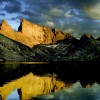Other Species Do Not
 “The most important questions have to do with the long-term behavior of systems,” says Indy Burke, University of Wyoming ecologist. The system she’s talking about, in this case, is western landscapes. And their behavior has to do with how the sagebrush and other vegetation recovers after disturbance. She, botanist Bill Lauenroth, and their graduate students have a paper coming out in the journal Ecosphere. The paper describes their study designed to learn how sagebrush grows back at abandoned oil and gas wells, but the most surprising finding was about another family of vegetation.
“The most important questions have to do with the long-term behavior of systems,” says Indy Burke, University of Wyoming ecologist. The system she’s talking about, in this case, is western landscapes. And their behavior has to do with how the sagebrush and other vegetation recovers after disturbance. She, botanist Bill Lauenroth, and their graduate students have a paper coming out in the journal Ecosphere. The paper describes their study designed to learn how sagebrush grows back at abandoned oil and gas wells, but the most surprising finding was about another family of vegetation.
The researchers used a “chronosequence” to look at well pad sites 30, 60, and even 90 years after abandonment. History is part of their experimental design. Instead of setting up a study and waiting for the site to age three to nine decades, they went to the Wyoming Oil and Gas Conservation Commission records and found oil and gas wells that had been abandoned 30 to 90 years ago.
“We had difficulty getting these papers published,” Burke says. The reviewers wanted to see controls and an experiment that could be replicated. “We don’t have any of that.” A controlled study would have required clearing a well pad, abandoning it, and monitoring it and the surrounding area for 90 years to see what happened.
Instead, the team identified 29 old, abandoned oil and gas wells in two areas of south central Wyoming. When they visited the sites, they found metal posts at the center of each pad bearing information that allowed them to identify the well and connect it to information stored in the Wyoming Oil and Gas Conservation Commission database.
The wells were abandoned between 1923 and 1980 and showed no sign of reclamation. They averaged about 40 yards in diameter. All were situated in a landscape dominated by Wyoming big sagebrush, with other shrubs, grasses, and wildflowers present. At each well pad site, the researchers measured the sagebrush height, cover, and density. They also recorded cover and density of three other categories of vegetation: non-sagebrush shrubs, grasses, and forbs. In addition, they recorded the same information for adjacent areas never disturbed by oil and gas development.
Sagebrush once covered an estimated 232,000 square miles across western North America, an area almost two and half times the size of Wyoming. Today, as much as half of that ecosystem has been lost due to invasive weeds and land use changes. Several iconic western species such as mule deer, pronghorn, Rocky Mountain elk, and pygmy rabbits, as well as birds including sage grouse, sage thrasher, and sage sparrow depend on sagebrush for habitat. Energy development is one of the primary causes of land disturbance in the sagebrush ecosystem, so understanding the long-term effects of such activities on the vegetation matters as we try to manage for those sagebrush-dependent species.
The findings from the study startled the researchers. “Sagebrush recovers but it takes 60-80 years,” says Burke. “Grasses recover fully very quickly,” she adds. But the forbs did not recover even after 90 years.
This last part was unexpected. Forbs include wildflowers and other small leafy, flowering, non-woody plants. Even though forbs don’t account for a very high percentage of vegetation in these sagebrush landscapes, they account for the most species and are a critical part of the ecosystem. Sage grouse, for example, need at least 10 percent forb cover for shelter and forage.
“If you’re patient the sagebrush will come back,” says Burke. “The forbs will take much longer.”
Because this research was designed to ask questions about sagebrush and the finding about wildflowers was incidental, Burke and her team are now returning to the well sites to survey individual forb species. They will also look for seeds in the soil to begin to understand whether forbs have trouble because their seeds don’t persist on abandoned well pads or if something else, like soil disturbance and compaction, is preventing their recovery. The results could help improve reclamation requirements to return old energy development sites to suitable habitat.
By Emilene Ostlind
Emilene Ostlind edits Western Confluence magazine.
Indy Burke directs the Haub School of Environment and Natural Resources at the University of Wyoming, home to the Ruckelshaus Institute, which publishes this magazine.
Further Reading
Otgonsuren Avirmed, William Lauenroth, Indy Burke, and Megan Mobley. “Natural recovery of a sagebrush plant community: Results from 30 to 88-year-old disturbed sites.” Ecosphere, in press.


